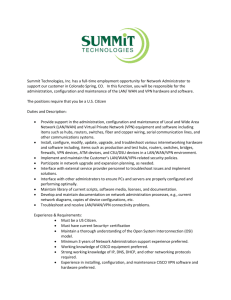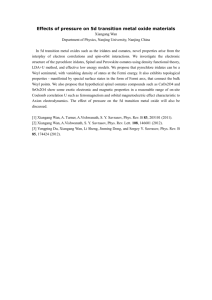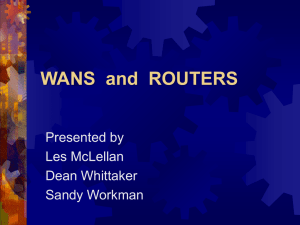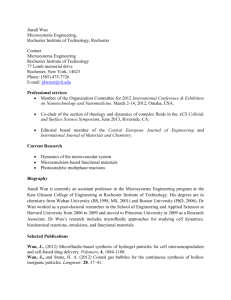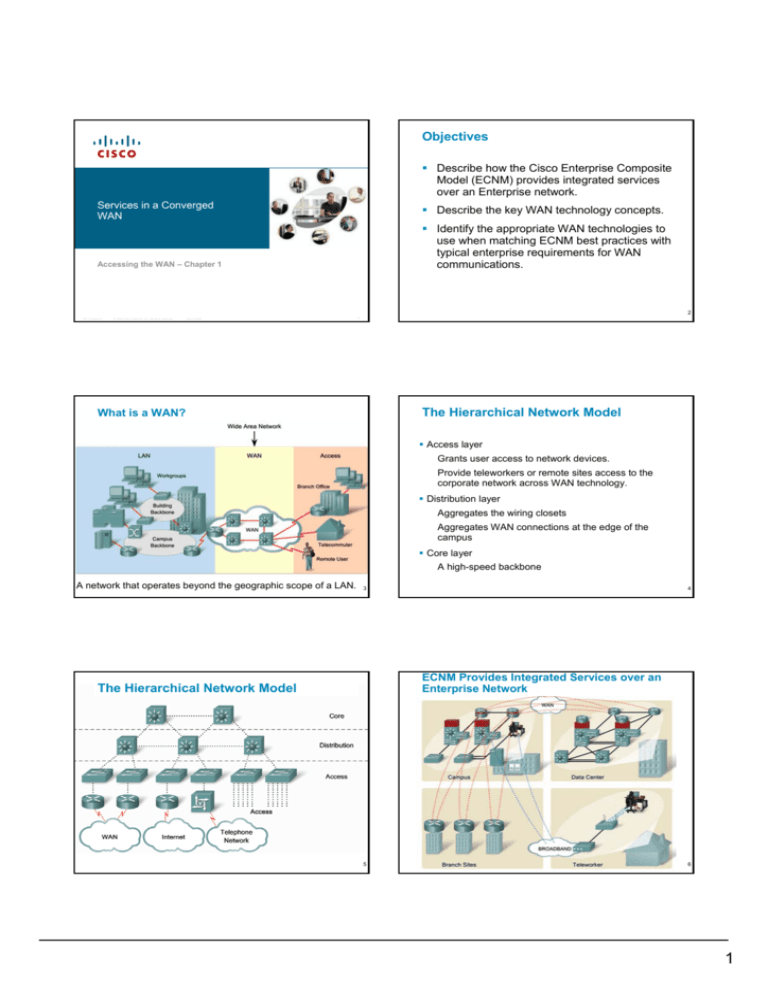
Objectives
Describe how the Cisco Enterprise Composite
Model (ECNM) provides integrated services
over an Enterprise network.
Services in a Converged
WAN
Describe the key WAN technology concepts.
Identify the appropriate WAN technologies to
use when matching ECNM best practices with
typical enterprise requirements for WAN
communications.
Accessing the WAN – Chapter 1
2
ITE I Chapter 6
© 2006 Cisco Systems, Inc. All rights reserved.
Cisco Public
1
The Hierarchical Network Model
What is a WAN?
Access layer
Grants user access to network devices.
Provide teleworkers or remote sites access to the
corporate network across WAN technology.
Distribution layer
Aggregates the wiring closets
Aggregates WAN connections at the edge of the
campus
Core layer
A high-speed backbone
A network that operates beyond the geographic scope of a LAN.
3
4
ECNM Provides Integrated Services over an
Enterprise Network
The Hierarchical Network Model
5
6
1
7
Key WAN Technology Concepts
8
WAN Physical Layer Terminology
WAN operations focus primarily on Layer 1 and Layer 2
9
WAN Devices
10
WAN Data Link Layer Protocols
11
12
2
WAN Frame Encapsulation Formats
Switching Technologies: Circuit Switching
Flag – e.g. 8-bit pattern 01111110
Dialup services - establishes a dedicated circuit between
terminals before the users may communicate.
Address field is not needed for WAN links, which are almost
always point-to-point.
Time division multiplexing (TDM) gives each conversation a
share of the connection in turn.
Control - content of the data is control information or
network layer data
Protocol – indicates the network layer protocol
13
Switching
SwitchingTechnologies:
TechnologiesPacket Switching
PSTN and ISDN are circuit-switching technologies that may
be used to implement a WAN in an enterprise setting.
14
WAN Link Connection Options
Splits data into packets that are routed over shared links
Two approaches:
Connectionless, e.g. the Internet
Connection-oriented
- Permanent virtual circuits (PVCs) , e.g. Frame relay
- Switched virtual circuits (SVCs)
15
Leased Line Types and Bandwidths
16
Integrated Services Digital Network (ISDN)
Basic Rate Interface (BRI) (Backup for leased line)
17
Primary Rate Interface (PRI)
18
3
Internet Connection Options
Packet Switching Technologies
Broadband Services - connect telecommuting employees to
a corporate site over the Internet.
DSL and Cable Modem
Broadband Wireless
WiMAX – range 10 miles.
Satellite Internet
X.25, Frame Relay,
ATM
VPN Technology
encrypted connection between private networks over
public networks such as the Internet.
For point-to-multipoint,
cheaper than using
multiple leased lines
a VPN uses virtual connections called VPN tunnels,
Metro Ethernet - broadens Ethernet to MANs
19
Choosing a WAN Service
Option
Lease line
Circuit
switching
Packet
switching
Cell relay
Internet
Desc.
P2P
dedicated
connection
For
Most secure
Against
Expensive
20
Summary
Services
PPP, HDLC
A WAN is defined as
A data communications network that operates
beyond the geographic scope of a LAN
Dedicated
circuit
between endpoints
Transmission Least
over PVCs or expensive
SVCs
Call setup
PSTN, ISDN
Uses fixed
length cells
Public
network
High b/w
Expensive
Least
expensive
Least secure, VPN, DSL,
variable b/w
Cable,
Wireless
WAN primarily operate on layer 1 & 2 of the OSI model
WAN technologies include
–Leased line
Shared
Frame relay,
media across X.25
link
–ISDN
–Frame relay
ATM
–X.25
–ATM
21
22
Summary
Cisco Enterprise Architecture
–This is an expansion of the hierarchical model that
further divides the enterprise network into
•Physical areas
•Logical areas
•Functional areas
Selecting the appropriate WAN technology requires
considering some of the following:
–WAN’s purpose
–Geographic scope of WAN
–Traffic requirements
–If WAN uses a public or private infrastructure
23
4




